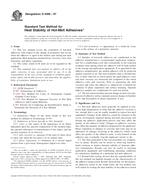Potřebujeme váš souhlas k využití jednotlivých dat, aby se vám mimo jiné mohly ukazovat informace týkající se vašich zájmů. Souhlas udělíte kliknutím na tlačítko „OK“.
ASTM D4499-07
Standard Test Method for Heat Stability of Hot-Melt Adhesives
Automaticky přeložený název:
Standardní zkušební metoda pro tepelné stability tavného lepidla
NORMA vydána dne 1.5.2007
Informace o normě:
Označení normy: ASTM D4499-07
Poznámka: NEPLATNÁ
Datum vydání normy: 1.5.2007
Kód zboží: NS-27483
Počet stran: 5
Přibližná hmotnost: 15 g (0.03 liber)
Země: Americká technická norma
Kategorie: Technické normy ASTM
Anotace textu normy ASTM D4499-07 :
Keywords:
color, heat stability, hot-melt adhesive, melt viscosity, phase separation, skin formation, ICS Number Code 83.180 (Adhesives)
Doplňující informace
| Significance and Use | ||||||||
|
Hot-melt adhesives must generally be applied at relatively high temperatures in order that the adhesive viscosity is low enough that it can be readily handled in typical hot-melt equipment. Changes in the adhesive caused by exposure to the severe environment required during hot-melt processing will disrupt the adhesive application process and may affect the quality of the adhesive bond. Changes in adhesive viscosity may affect the quantity of adhesive dispensed by the applicator. Phase separation or changes in viscosity and color may be an indication of changes occurring in the adhesive which could affect the quality of the adhesive joint. A skin formed on the adhesive may eventually clog the applicator nozzle or die. The data generated in this test procedure are comparative in nature. Results can be useful in observing batch-to-batch variation or relative thermal stability of alternate adhesive formulations. Results can also be useful in selecting application equipment and establishing operating conditions for satisfactory handling of a particular hot-melt adhesive. Round-robin testing showed that the reproducibility of this test method can depend strongly on the characteristics of the adhesive being tested. Results showed that, for the particular adhesives tested in the round robin, the test method was well suited for testing the heat stability of the adhesives based on an EVA copolymer, a polyolefin, and a polyamide. However, because of poor reproducibility, the test method proved to be unsuitable for assessing the heat stability of the adhesive based on a block copolymer. Precision of this test method is discussed in Section 11. |
||||||||
| 1. Scope | ||||||||
|
1.1 This test method covers the evaluation of hot-melt adhesives with respect to the change in properties that occurs while the adhesive is aged in the molten state during hot-melt application. Melt properties monitored are viscosity, color, skin formation, and phase separation. 1.2 The values stated in SI units are to be regarded as the standard. This standard does not purport to address all of the safety concerns, if any, associated with its use. It is the responsibility of the user of this standard to establish appropriate safety and health practices and determine the applicability of regulatory limitations prior to use. |
||||||||
| 2. Referenced Documents | ||||||||
|
Doporučujeme:
Aktualizace zákonů
Chcete mít jistotu o platnosti užívaných předpisů?
Nabízíme Vám řešení, abyste mohli používat stále platné (aktuální) legislativní předpisy.
Chcete vědět více informací? Podívejte se na tuto stránku.




 Cookies
Cookies
